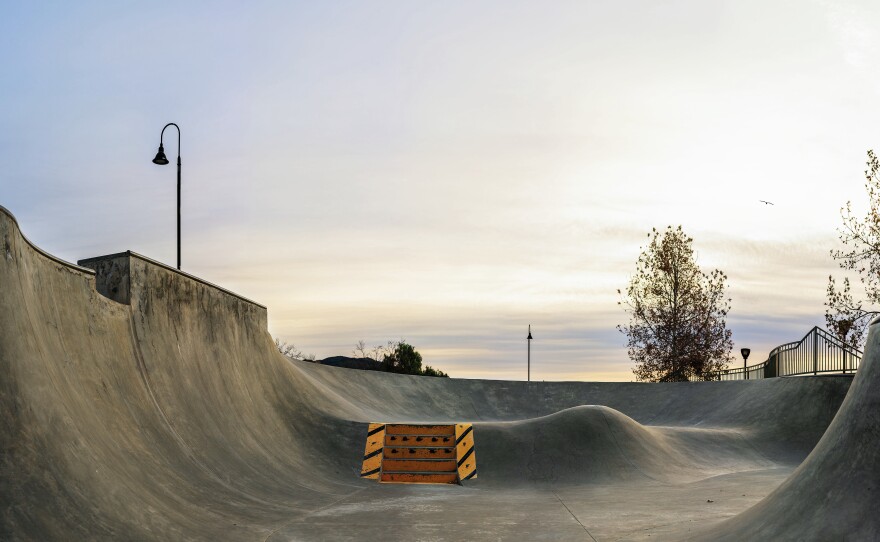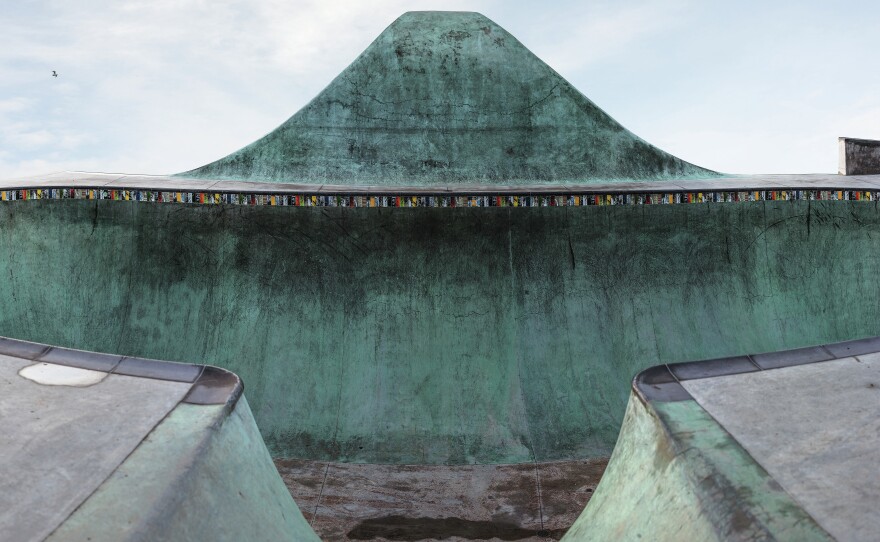Undulating bowls, sloping half-pipes, cavernous barrels. A towering cradle that resembles Yosemite's Half Dome.
Devoid of their usual inhabitants, the skate parks dotting the stretches of California are alone works of art in the eyes of photographer Amir Zaki.
His new photo-book, California Concrete: A Landscape of Skateparks, features Zaki's photos of 12 major skate parks throughout the Golden State. The brutalist structures that emerge at these sites, from San Jose's Cunningham Lake to Linda Vista in San Diego, fill a void in landscape photography and capture a pivotal cultural moment.


Years before the concrete had poured into these elaborate parks, Zaki grew up skateboarding the suburban streets and backyard wooden ramps of sprawling Beaumont, Calif., in the 1980s — the generation that followed the sport's counterculture beginnings in Southern California.
In the mid-1970s, a severe California drought kick-started modern skateboarding in suburban backyards. For skaters, carving the steep curves of empty pools — drained to save water — mimicked the thrill of surfing when the waves were flat.
A new vertical athleticism forged in those kidney-shaped pools revived a dormant fad of skateboarding on flat ground and accelerated the construction of concrete skate parks — playgrounds that set the stage for stylish aerial stunts perfected at the X Games in the '90s.
Next year, the sport reaches prime time with its 2020 Olympic Games debut.

Like the mischievous, fence-hopping youth who would scout vacant pools to shred, Zaki found opportunity in emptiness.
A couple of years ago, Zaki started visiting the parks at the crack of dawn, before skaters would show up, to capture his photos. Now 45 and admittedly not as agile, Zaki describes photographing skate parks as its own athletic feat. He would crawl into the concrete bowls, crouch and soak in the solitude.
"It was magical," he said. "The light was incredible. Having the place to myself really allowed me to study the spaces and contemplate them carefully. The mindset is very different than that of a skater who is waiting their turn to take a run. Time seemed to slow down for me there."
That meditative philosophy is rooted in Zaki's appreciation for Eastern contemplative traditions, he said.
"I consider that photographing simply their formations implies their use. One can easily imagine a skateboarder flying through the air without seeing them," Zaki said. "They become more imaginative and open as spaces for me. There is a parallel with meditative practices that allow one to quiet and empty the mind of so much activity to leave room for the good stuff."
He hopes his audience feels the same.

Though some of his final prints can span as large as 60 inches by 75 inches, the images retain a sharpness that evokes a hyperrealist scene. Onlookers can absorb the infinitesimal cracks that bear structural wear, from the vantage point of someone scaling the park's depths.
Zaki, who calls himself a "child of the digital age," uses a unique, high-tech process. He mounts a high-end DSLR camera onto a GigaPan motorized tripod head to pan the site. Each photo is a composite of a dozen to several dozen photos that Zaki later stitches together with software to produce a high-resolution image.



What results, Zaki said, is all but a fisheye effect. "The lens I use is somewhat telephoto, which flattens the space in each individual frame, yet the overall angle of view is often quite wide, which exaggerates spatial depth," he said.
"There is a visual push and pull, a subtle contradiction and peculiarity in how space is rendered using this technology. This process also allows me to photograph in certain tight areas and from difficult positions that would be impossible to capture otherwise."
He eliminates the "distractions" of stickers and vandalism during the editing stage. The five to 10 minutes that pass between each photo's series of lens shutters also yield a bit of eye trickery. Light, wind or birds entering the frame can cause blurring.
"Ultimately, what the viewer sees are not decisive 'moments' in time but images that are a blending of an extended temporal experience, which allude to an expansive sense of time," he said.
Zaki acknowledges the prolific discipline of skater-centric skateboard photography, showcased in the seminal skateboarding magazine Thrasher, for one. But his eye is trained elsewhere.

"The background for me becomes the primary subject," he said. "Every crack and detail, the play of light and shadow, the monumentality, the quietude and emptiness are all intended to be contemplative spaces for the viewer to enjoy."
As such, Zaki said he prioritizes the viewer by replicating vision and experience.
"I also want to invite the viewer to be the primary subject of the work, especially those who have never been to these parks, to experience these spaces in a visceral, bodily and engaging way."
"Exalting the banal to the monumental" has been a throughline in his work, he said. He hopes viewers will walk away from his photos with a new perspective on the man-made landscapes that surround them.
"I want people to feel tension between what they think is familiar and something somewhat alienating or unusual," he said. "The landscape, both natural and built, has a rich tradition found in photography and painting. I build upon that history but with less reverence for the 'documentary' and more emphasis on desire."
Copyright 2023 NPR. To see more, visit https://www.npr.org. 9(MDAzMjM2NDYzMDEyMzc1Njk5NjAxNzY3OQ001))







